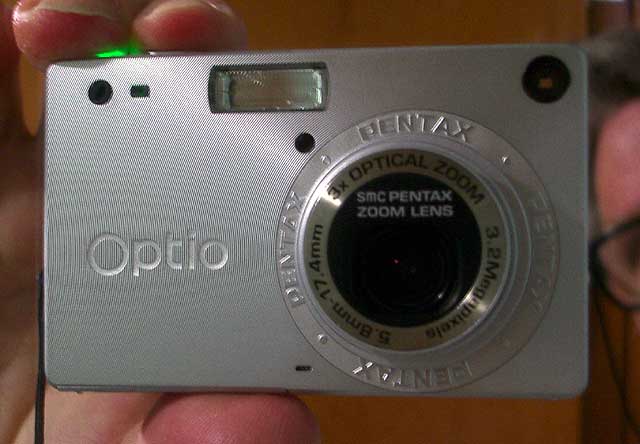My Pentax Optio S camera just arrived, after a hair-raising three weeks of worrying about the shipment coming in time for the upcoming Europe trip. Whew. Nothing like getting a new geek toy a few days before one’s birthday. Many thanks to the nice folks at B&H Photo Video for making my deadline. Here are my first impressions.
Besides the camera itself, which has 11MB built-in memory, I bought two SanDisk 256MB memory cards and a PQI FPTS-D-US TravelFlash card reader/writer with USB interface. The reader comes with an installation CD for various Windows flavors and for Classic Mac OS; no installation was necessary for Mac OS X. It’s small and light but the bulges on the side interfere (by a millimeter or so) with the neighboring USB connector on my iBook; there’s enough “give” to make it fit, though, and a 60-cm USB extension cable is included.
The SD (Secure Digital) cards are postage-stamp sized and have a write-protect switch, which seems very convenient. They come in a bulkier plastic case, probably because they’d be easy to lose otherwise. The 256MB size is the most cost-effective right now. Both came preformatted and Mac OS X could see them with no trouble. Interestingly, the packaging included both a magnetic-wire tag and a RFID tag… the latter seem to be getting very popular lately.
Going back to the camera itself, it comes in a surprisingly small box which is very tightly packed. The bulkiest items are the battery charger and the various cables – an USB cable, the charger’s power cable, and the video out cable for connecting to a TV, and a smaller bag with the camera strap. The manual is conveniently small-sized too. The battery and camera themselves are so small and discreetly packed in a size pocket of the box that I had a momentary panic attack ![]() .
.
The manual recommends charging the battery first, so that’s what I’m did while typing this. it’s supposed to take 100 minutes or less. The battery slides into the charger but isn’t held too tightly, so I’ll be careful not to handle the charger while it’s operating. As the charger’s power cable is long and bulky, I’ll probably travel with my iBook’s adapter plug instead. Meanwhile, I attached the camera strap first of all, as handling the camera without it was quite anxiety-provoking; it was so light I was afraid to fumble and drop it. The camera-side end of the strap itself looks very thin too. That said, the gripping surfaces, though small, are well placed and roughened by circular concentric grooves. The grooves are centered on the lens in front and on the four-way button in back, and contribute to the camera’s jewel-like appearance.
The accompanying CD has drivers for Windows and Classic Mac OS, as well as Windows and Mac versions of ACDSee, an image browser. Curiously, the version on the CD was 1.6.9, quite more recent than the one listed on VersionTracker. There’s no mention of a newer version on the ACDSee site.
On the first power-up, the camera asks for some setup information, like menu language, geographical location, and date and time. After some fumbling and belated checking of the manual, I think I’ve got the hang of the menu system. The four-way button on the back at first seems a little flaky, like the reviews warned me, but working it with a fingernail works OK. The camera has an enormous range of options, I’ve barely scratched the surface after about an hour of fiddling.
The top of the camera has the power button on the right and the shutter release next to it. Worries that they’d be too easy to confuse were unfounded, as the power button is slightly recessed and the shutter release falls naturally under the right index finger. The zoom in/out buttons are a little less convenient as they fall under the thumbtip. Zooming seems to work in discrete steps, which I’d never seen before in a camera.
So far, I’ve checked out the various flash, focusing and zooming options and some of the media formats. The sound recording feature records over 16 hours (!) of sound on a 256MB card at 8 KHz mono – this generates a .wav file. Not really useful for concert bootlegging, but it’s quite sufficient for interviews and meetings. You can also record a sound clip of up to 30 secs for each photo – useful for the “shoot first and ask later” approach.
The video recording feature records up to 30 seconds of “Motion JPEG OpenDML” video, at 320×240 pixels, around 12 fps, with 8KHz mono sound. The finished file is in .avi format and averages around 2.7MB size in my tests. Clips look reasonable on a TV, considering the low pixel size. It seems that the video output (which can be switched between PAL and NTSC) just mirrors whatever appears on the LCD; this may be interesting for teaching purposes.
I’ve figured out that, as long as I imitate Pentax’s numbering conventions, I can upload existing photos to a card and have the camera display it; of about 70 test images, 8 seemed to be in an uncompatible format, quite puzzling as they were all tweaked and saved in Photoshop. Later on I’ll try to save the same image with several options to narrow this down. This will be very useful on the trip, it beats carrying dozens of photo albums…
No time for now to fiddle around with actual test images, but here’s a slightly cropped and reduced self-portrait:

I’ll be taking the camera to a party later today as a first field-test. Hopefully I’ll be able to post some actual test images and more comments in a few days…
